A Kirkwood is a gap or dip in the distribution of the semi-major axes or the orbital periods of the main-belt asteroids. They correspond to the locations of orbital resonances with Jupiter.
Key Facts & Summary
- Asteroids are not distributed uniformly, and thus some regions contain very few of them. These regions are called Kirkwood gaps.
- The orbital resonances with Jupiter cleared the asteroids from their locations due to dominant gravitational influence.
- If an asteroid with a semi-major axis of 3.28 AU will complete two orbits around the Sun for every orbit of Jupiter, the asteroid lies in a 2:1 orbital resonance.
- The repeated tugs from Jupiter will change the orbital elements of an asteroid, which can either create a gap or a concentration of asteroids at a certain distance.
- Any asteroids with orbital distances that form a simple ratio with that of Jupiter will suffer from gravitational perturbations.
- Many of the key Kirkwood gaps occur at the 2:1, 3:1, 5:2, and 7:3 orbital resonances.
- The significant concentrations of asteroids are found at the 3:2 and 1:1 orbital resonances. These asteroids are usually Trojan asteroids.
Few asteroids have a semi-major axis near 2.50 AU or a period of 3.95 years. This would make three orbits for each orbit of Jupiter – the reason why it is called 3:1 orbital resonance.
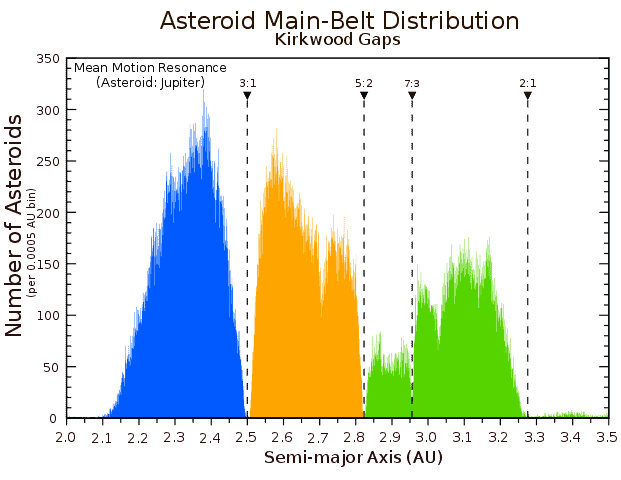
Some orbital resonances correspond to orbital periods whose lengths are merely fractions of Jupiter’s. These weak resonances lead to a depletion of asteroids, while spikes in the histogram are often due to the presence of prominent asteroid families. These gaps were first noticed in 1866 by professor Daniel Kirkwood.
Observations
Most of the Kirkwood gaps are depleted, unlike the mean-motion resonances of Neptune or Jupiter’s 3:2 resonance, which usually retains captured objects at least from the Nice model point of view.
This loss in the Kirkwood gaps is due to the overlapping V5 and V6 secular resonances within the mean-motion resonances. Such orbital elements vary chaotically as a result and evolve onto planet-crossing orbits within a few million years.
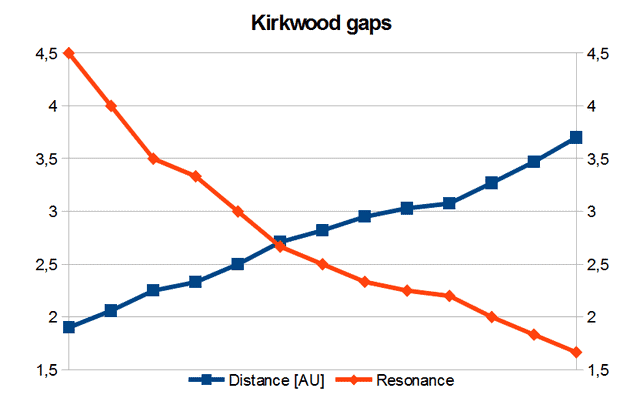
The 2:1 mean-motion resonance has a few relatively stable islands within the resonance, however. The islands are depleted due to slow diffusion onto less stable orbits.
These events are linked to Jupiter and Saturn being near a 5:2 resonance. Some asteroids have been observed to have high eccentric orbits that do lie within the Kirkwood gaps. Some of these asteroid groups include the Alinda and Griqua group.
Such orbits increase in their eccentricity on a timescale of tens of millions of years. It will eventually break out of the resonance due to close encounters with a major planet.
Main Gaps
The most prominent Kirkwood gaps are located at mean orbital radii of:
2.06 AU – 4:1 resonance
2.5 AU – 3:1 resonance – Alinda group of asteroids
2.82 AU – 5:2 resonance
2.95 AU – 7:3 resonance
3.27 AU – 2:1 resonance – Hecuba gab – Griqua group of asteroids.
Some of the weaker Kirkwood gaps are also found at:
1.9 AU – 9:2 resonance
2.25 AU – 7:2 resonance
2.33 AU – 10:3 resonance
2.71 AU – 8:3 resonance
3.03 AU – 9:4 resonance
3.075 AU – 11:5 resonance
3.47 AU – 11:6 resonance
3.7 AU – 5:3 resonance
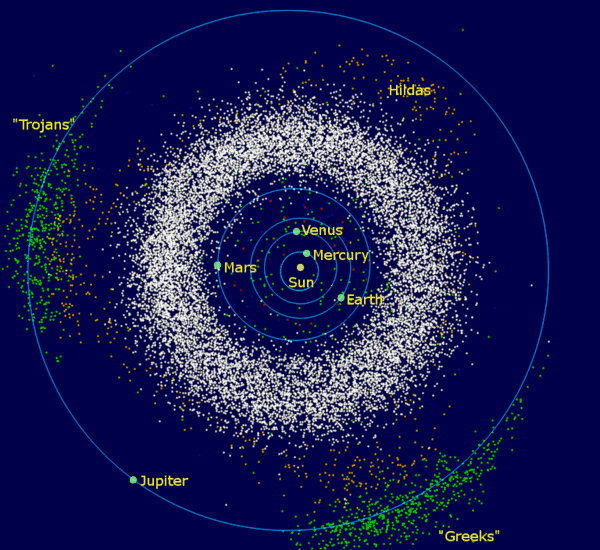
Asteroid Zones
Gaps cannot be seen in a simple snapshot since the orbits of asteroids are elliptical, and many of these celestial objects still cross through the radii corresponding to the gaps.
The spatial density of asteroids in such gaps does not differ significantly from the neighboring regions. Most of the main gaps occur at the 3:1, 5:2, 7:3, and 2:1 mean-motion resonances with Jupiter.
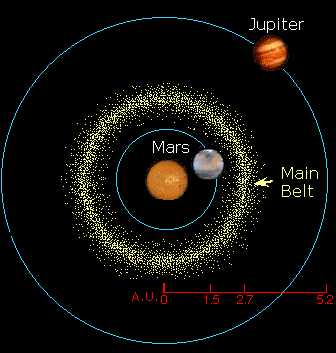
An asteroid in the 3:1 Kirkwood gap would orbit the Sun around three times for each Jovian orbit, for example. The weaker resonances occur at other semi-major axis values, with fewer asteroids found than nearby.
The core population of the asteroid belt is divided into the inner and outer zones. They are separated by the 3:1 Kirkwood gap at 2.5 AU. The outer zone may be further divided into middle and outer zones by the 5:2 gat at 2.82 AU:
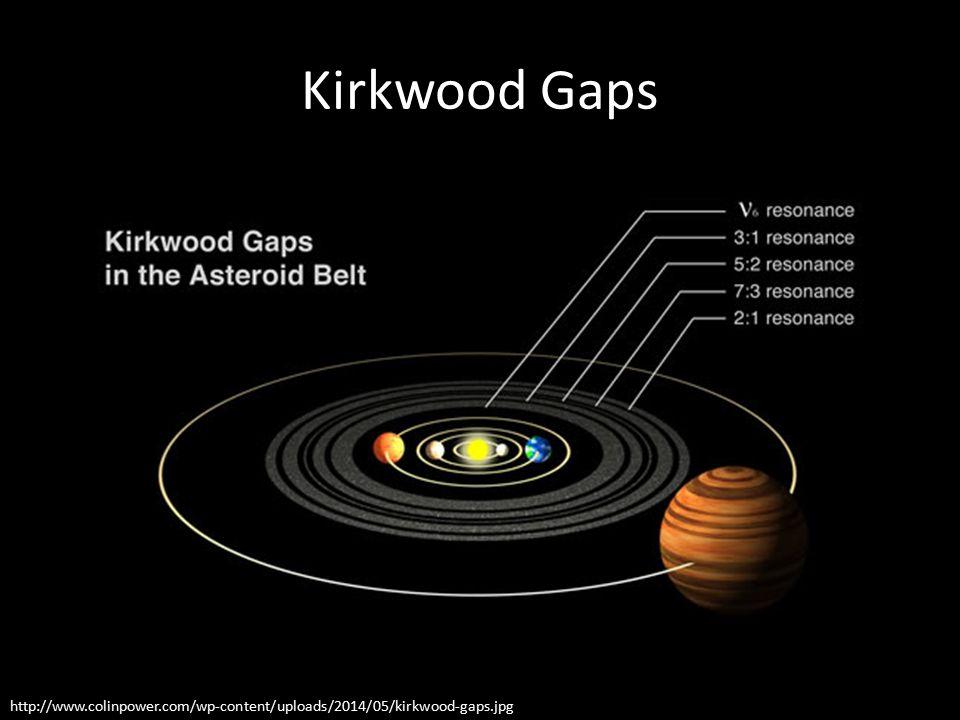
4:1 resonance – 2.06 AU – Zone I population, aka inner zone.
3:1 resonance – 2.5 AU – Zone II population, aka middle zone.
5:2 resonance gap – 2.82 AU – Zone III population, aka outer zone.
2:1 resonance gap – 3.28 AU
For the inner zone, the largest asteroid is 4 Vesta, which has a diameter of 525 km / 326 mi.
In the middle zone, the most massive asteroids are Ceres, with a diameter of 945 km / 587 mi and 2 Pallas at 510 km / 320 mi.
For the outer zone, 10 Hygiea is the most massive asteroid, having a diameter of 434 km / 270 mi.
Beyond the outer zone, it remains a mystery; however, the asteroid 87 Sylvia is believed to be the most massive there, having a diameter of 280 km / 175 mi.
The Future
In millions of years from now, many asteroids will break out of the resonances due to gravitational interactions with other planets. However, the asteroid belt already has its faith sealed. In around 5 to 6 billion years, the Sun’s light will most likely shatter the asteroid belt with radiation. The powerful radiation from this last dying light will warm up and destroy the asteroids.
Did you know?
- The Kirkwood gaps are the primal source of near-Earth asteroids.
- Collisions between asteroids have their orbits perturbed by the Yarkovsky effect, and as such, they drift into the Kirkwood gaps.
- Because of the Kirkwood gaps, some asteroids might completely exit the solar system.
- Some of the most famous Earth-crossing asteroids caused by the Kirkwood gap are the Aten and Apollo groups.
Sources:
Image sources:
- https://upload.wikimedia.org/wikipedia/commons/thumb/d/d3/Kirkwood_Gaps.svg/621px-Kirkwood_Gaps.svg.png
- https://upload.wikimedia.org/wikipedia/commons/thumb/f/f4/Kirkwood_gaps_-_distances_and_resonances.png/640px-Kirkwood_gaps_-_distances_and_resonances.png
- https://www.universetoday.com/wp-content/uploads/2009/06/asteroid_belt-e1462486202701.png
- http://spaceguard.rm.iasf.cnr.it/NScience/neo/images/ast-mainbelt.gif
- https://images.slideplayer.com/22/6376705/slides/slide_29.jpg
